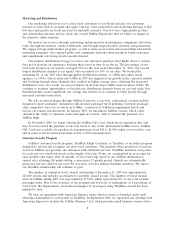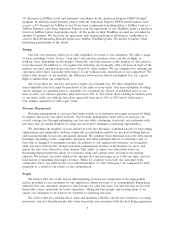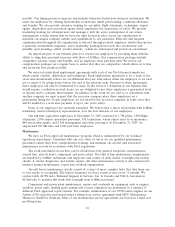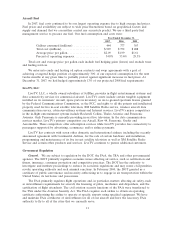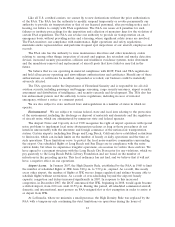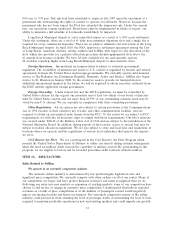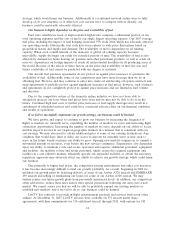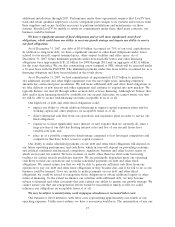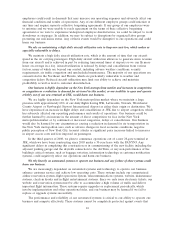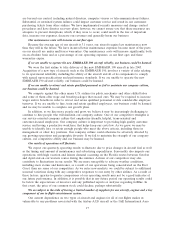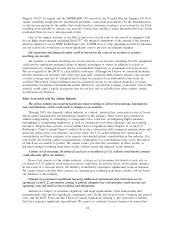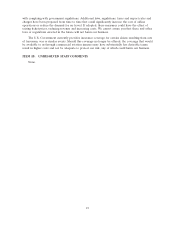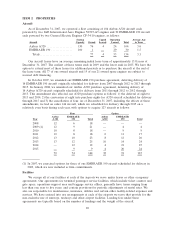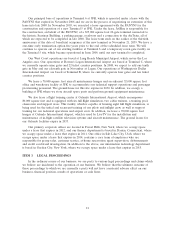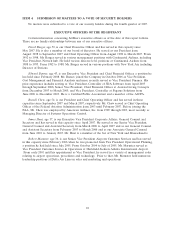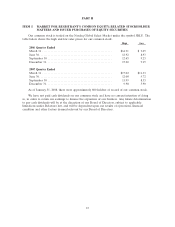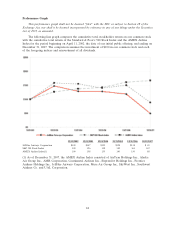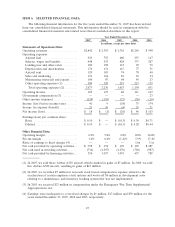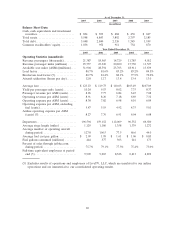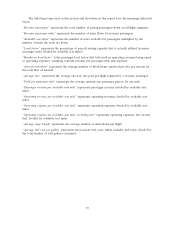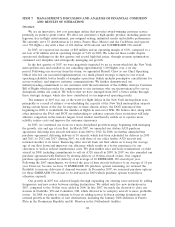JetBlue Airlines 2007 Annual Report Download - page 28
Download and view the complete annual report
Please find page 28 of the 2007 JetBlue Airlines annual report below. You can navigate through the pages in the report by either clicking on the pages listed below, or by using the keyword search tool below to find specific information within the annual report.Engines V2527-A5 engine and the EMBRAER 190 aircraft or the General Electric Engines CF-34-10
engine, including design defects, mechanical problems, contractual performance by the manufacturers,
or adverse perception by the public that would result in customer avoidance or in actions by the FAA
resulting in an inability to operate our aircraft. Carriers that operate a more diversified fleet are better
positioned than we are to manage such events.
One of the unique features of our fleet is that every seat in each of our aircraft is equipped with
free in flight entertainment including DirecTV®. An integral component of the system is the antenna,
which is supplied to us by EMS Technologies, Inc. If EMS were to stop supplying us with its antennas
for any reason, we would have to incur significant costs to procure an alternate supplier.
Our reputation and financial results could be harmed in the event of an accident or incident
involving our aircraft.
An accident or incident involving one of our aircraft, or an aircraft containing LiveTV equipment,
could involve significant potential claims of injured passengers or others in addition to repair or
replacement of a damaged aircraft and its consequential temporary or permanent loss from service.
We are required by the DOT to carry liability insurance. Although we believe we currently maintain
liability insurance in amounts and of the type generally consistent with industry practice, the amount
of such coverage may not be adequate and we may be forced to bear substantial losses from an
accident. Substantial claims resulting from an accident in excess of our related insurance coverage
would harm our business and financial results. Moreover, any aircraft accident or incident, even if fully
insured, could cause a public perception that we are less safe or reliable than other airlines, which
would harm our business.
Risks Associated with the Airline Industry
The airline industry has incurred significant losses resulting in airline restructurings, bankruptcies
and consolidations, which could result in changes in our industry.
Through 2005, the domestic airline industry, as a whole, reported five consecutive years of losses,
which caused fundamental and permanent changes in the industry. These losses have resulted in
airlines renegotiating or attempting to renegotiate labor contracts, reconfiguring flight schedules,
furloughing or terminating employees, as well as consideration of other efficiency and cost-cutting
measures. Despite these actions, several airlines have reorganized under Chapter 11 of the U.S.
Bankruptcy Code to permit them to reduce labor rates, restructure debt, terminate pension plans and
generally reduce their cost structure. In recent years, the U.S. airline industry has experienced
consolidation and there continue to be reports of potential further consolidation in the industry. It is
foreseeable that further airline reorganizations, bankruptcies or consolidations may occur, the effects
of which we are unable to predict. We cannot assure you that the occurrence of these events, or
potential changes resulting from these events, will not harm our business or the industry.
A future act of terrorism, the threat of such acts or escalation of U.S. military involvement overseas
could adversely affect our industry.
Even if not directed at the airline industry, a future act of terrorism, the threat of such acts or
escalation of U.S. military involvement overseas could have an adverse effect on the airline industry.
In the event of a terrorist attack, the industry would likely experience significantly reduced demand.
We cannot assure you that these actions, or consequences resulting from these actions, will not harm
our business or the industry.
Changes in government regulations imposing additional requirements and restrictions on our
operations or the U.S. government ceasing to provide adequate war risk insurance could increase our
operating costs and result in service delays and disruptions.
Airlines are subject to extensive regulatory and legal requirements, both domestically and
internationally, that involve significant compliance costs. In the last several years, Congress has passed
laws, and the DOT, FAA and the TSA have issued regulations relating to the operation of airlines
that have required significant expenditures. We expect to continue to incur expenses in connection
18


